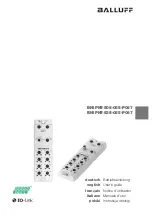
User’s Manual – A16 J A18 J Series
Page 36
The table below shows the load-bearing capacity of different types of ground.
For the max pressure on the ground by the single wheel, please refer to the data contained in the specific tables of each
model (chapter 2, TECHNICAL FEATURES OF STANDARD MACHINES).
Using the machine is forbidden if the max pressure on the ground per wheel is above the load-
bearing capacity of the specific type of ground on which the machine is to be used.
TYPES OF GROUND
BEARING CAPACITY IN Kg/ cm²
Non-compact filling earth
0
–
1
Mud, peat, etc.
0
Sand
1.5
Gravel
2
Friable earth
0
Soft earth
0.4
Rigid earth
1
Semi-solid earth
2
Solid earth
4
Rocks
15 - 30
Should you have any doubts, verify the load-bearing capacity with specific tests.
In case of constructed surfaces (concrete floors, bridges, etc.) the load-bearing capacity must be provided by the builder.
3.3.6.
High-voltage lines.
The machine is not electrically insulated and is not protected in case of contact with or proximity to power lines.
A minimum distance must be kept from power lines according to applicable laws and the following table.
Type of power lines
Voltage (KV)
Minimum distance (m)
Light poles
<1
3
1-10
3.5
10 - 15
3.5
15 - 132
5
132 - 220
7
220 - 380
7
High-voltage pylons
>380
15
3.4.
Hazardous situations and/or accidents
If, during preliminary control operations or use, the operator discovers a defect that could turn to a hazardous
situation, the machine must be placed in safety conditions (confined with warning signs) and the employer must be
notified immediately.
If, during use, an accident occurs, with injury to the operators, caused by operating errors (e.g., collisions) or any
structural yielding, the machine must be placed in
safety conditions
(confined and identified by effective warnings)
and the employer must be notified about the fault.
In case of an accident with injuries to one of more operators, the operator on the ground (or on a platform not
involved in the accident) must:
Seek help immediately.
Perform the operation to return the platform to the ground only if he is certain this will not make the
situation worse.
Place the machine in safety condition and notify the fault to the employer.
Summary of Contents for A16 J Series
Page 14: ...User s Manual A16 J A18 J Series Page 14...
Page 17: ...User s Manual A16 J A18 J Series Page 17...
Page 20: ...User s Manual A16 J A18 J Series Page 20...
Page 23: ...User s Manual A16 J A18 J Series Page 23...
Page 26: ...User s Manual A16 J A18 J Series Page 26...
Page 29: ...User s Manual A16 J A18 J Series Page 29...
Page 87: ...User s Manual A16 J A18 J Series Page 87...
Page 106: ...User s Manual A16 J A18 J Series Page 106 029 08 144...
Page 107: ...User s Manual A16 J A18 J Series Page 107 029 08 149...
Page 108: ...User s Manual A16 J A18 J Series Page 108 029 08 161...
Page 109: ...User s Manual A16 J A18 J Series Page 109 029 08 171...
Page 110: ...User s Manual A16 J A18 J Series Page 110 029 08 128...
Page 111: ...User s Manual A16 J A18 J Series Page 111 029 08 129...
Page 112: ...User s Manual A16 J A18 J Series Page 112 029 08 150...
Page 113: ...User s Manual A16 J A18 J Series Page 113 029 08 132...
Page 114: ...User s Manual A16 J A18 J Series Page 114 029 08 158...
Page 115: ...User s Manual A16 J A18 J Series Page 115 029 08 148...
Page 116: ...User s Manual A16 J A18 J Series Page 116 029 08 147...
Page 117: ...User s Manual A16 J A18 J Series Page 117...
Page 119: ...User s Manual A16 J A18 J Series Page 119...
















































